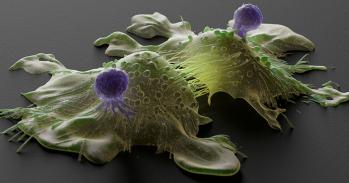
Cancer imaging is set to get a major boost from a £35 million nationwide initiative to develop cutting edge imaging technologies for basic and clinical cancer research.
Cancer imaging is set to get a major boost from a £35 million nationwide initiative to develop cutting edge imaging technologies for basic and clinical cancer research.
Being able to see what’s happening inside a patient is vitally important in understanding how treatments are working and the best ways to improve them
Dr Iain Foulkes
Cancer Research UK and the Engineering and Physical Sciences Research Council (EPSRC) are committing £35 million for five years to four separate cancer imaging centres across the country. One centre will be a joint venture between the University of Manchester and the University of Cambridge, combining cutting-edge translational research and clinical trials with state-of-the-art imaging, genomics and pre-clinical research.
Professor Kevin Brindle, lead researcher for the imaging centre at the University of Cambridge, has developed a technique in collaboration with GE Healthcare which increases the sensitivity of MRI by 10,000 – 100,000 times. This new technique, termed “hyperpolarisation”, can detect whether cancer cells have stopped growing in response to treatment, which may not be apparent by just looking at the size of the tumour by conventional MRI. As well as hyperpolarised MRI the centre will also develop fluorescence endoscopy with targeted imaging agents to detect early stage lesions in the oesophagus, a targeted radiolabelled imaging agent for detecting tumour cell death and photoacoustic imaging as new method for assessing tumour hypoxia.
Dr Iain Foulkes, Cancer Research UK’s executive director of strategy and research funding, said: “Imaging is an invaluable tool in the fight against cancer. Being able to see what’s happening inside a patient is vitally important in understanding how treatments are working and the best ways to improve them.”
The three other imaging centres to receive funding are the University of Oxford, The Institute of Cancer Research, London, and a joint imaging centre between King’s College London and University College London.
The centre in Oxford aims to integrate basic research in chemistry, physics and cancer biology with imaging science to guide treatment choices for cancer patients. The centre at King’s College London and University College London will focus on determining the differences in a patient’s tumour and in bringing new imaging methods to the clinic. Finally, the centre at The Institute of Cancer Research, London is part of the largest comprehensive Cancer Centre in Europe and will focus on enabling ‘personalised’ medicine for each individual patient.
These four centres will serve as focal points of world-class research using a variety of techniques, such as optical microscopy, MRI (magnetic resonance imaging), functional MRI, ultrasound, and PET (Positron Emission Tomography). Researchers will have access to a large patient population and vital clinical trials infrastructure.
Professor David Delpy, chief executive of the EPSRC, said: “This large investment is great news and builds upon our previous successful collaboration with Cancer Research UK. These centres will bring together many of the UK’s leading scientists, engineers and clinicians interested in all aspects of imaging research, speeding up advances in new technologies and ensuring these are applied rapidly for the benefit of patients.”
This work is licensed under a Creative Commons Licence. If you use this content on your site please link back to this page.





